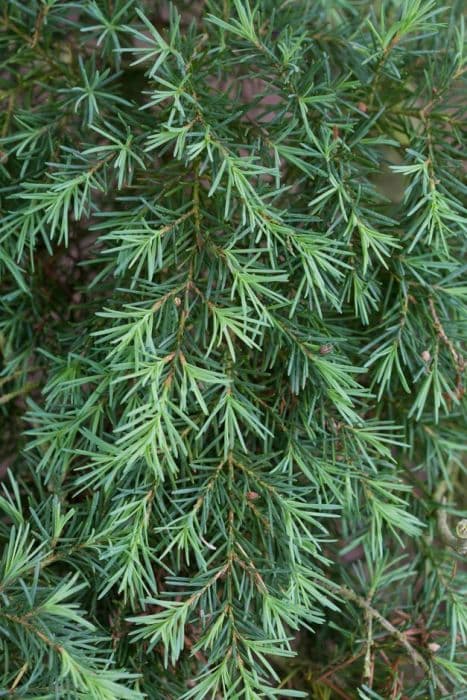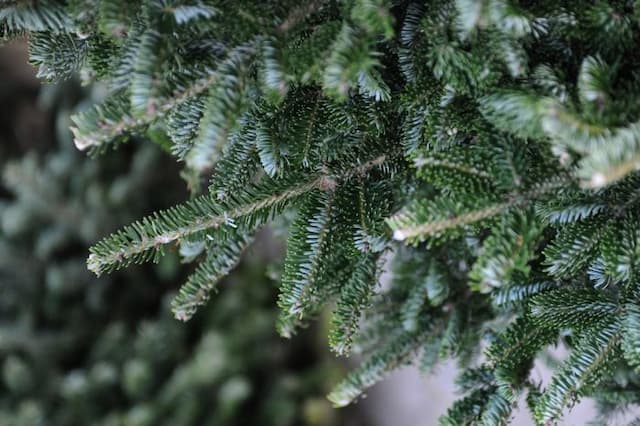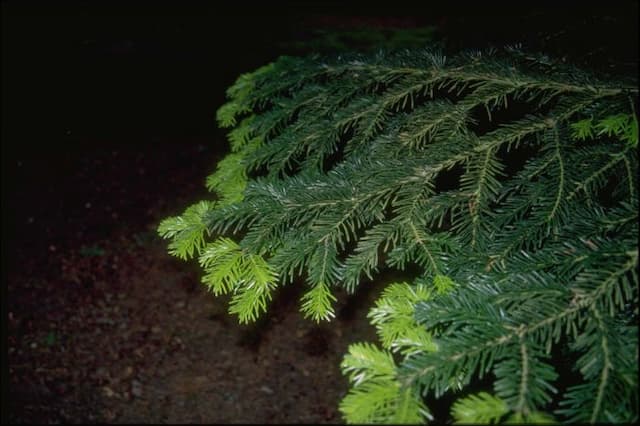Mountain Hemlock Tsuga mertensiana

ABOUT
The plant commonly known as the mountain hemlock has a graceful and elegant appearance characterized by a conical shape that typically tapers to a narrow point at the top. The branches grow horizontally and may droop slightly at the tips, giving it a soft, somewhat weeping look. The needles of the mountain hemlock are short, measuring about half an inch long, and are arranged spirally around the branches. They have a bluish-green color with a white line on the underside, which adds a subtle contrast and visual interest. The bark is another distinctive feature, starting out smooth and gray when the tree is young and becoming furrowed, ridged, and brownish as it matures, providing a rugged texture. The cones are small, about 1 to 3 inches long, and hang downwards from the branches. Initially green and blending in with the foliage, they mature to a brown color that contrasts with the leaves. The overall appearance of the mountain hemlock is one of a serene and hardy plant that embodies the beauty and resilience of alpine environments.
About this plant
 Names
NamesFamily
Pinaceae.
Synonyms
Mountain Hemlock, Mertens' Hemlock, Black Hemlock, Hemlock Spruce.
Common names
Abies mertensiana, Pinus mertensiana, Tsuga pattoniana, Tsuga crassifolia.
 Toxicity
ToxicityTo humans
Mountain Hemlock (Tsuga mertensiana) is not commonly known to be toxic to humans. There are no well-documented cases of poisoning or toxicity from ingesting this plant. However, as with any plant material, consuming non-edible parts in large quantities may cause gastrointestinal discomfort or other non-specific symptoms. Always exercise caution and consult with a medical professional or a poison control center if you suspect poisoning from any plant material.
To pets
Mountain Hemlock (Tsuga mertensiana) is also not commonly known to be toxic to pets. Similar to its effects on humans, there are no significant reports of toxicity in domestic animals from this tree. Pets should not be encouraged to ingest plant material, as it can potentially cause gastrointestinal upset. If you suspect your pet has ingested a large amount of any plant and is showing symptoms of distress, it is best to consult a veterinarian.
 Characteristics
CharacteristicsLife cycle
Perennials
Foliage type
Evergreen
Color of leaves
Green
Height
20-30 feet (6-9 meters)
Spread
10-15 feet (3-4.5 meters)
Plant type
Tree
Hardiness zones
5-7
Native area
North America
Benefits
 General Benefits
General Benefits- Habitat Support: Tsuga mertensiana, commonly known as Mountain Hemlock, provides essential habitat and food for wildlife, including birds and mammals.
- Erosion Control: The root system of Mountain Hemlock helps stabilize soil and prevent erosion on mountain slopes.
- Aesthetic Value: With its conical shape and dense, blue-green foliage, Mountain Hemlock is often used in landscapes for beautification.
- Climate Regulation: Like many trees, Mountain Hemlock plays a role in carbon sequestration, capturing carbon dioxide from the atmosphere and thereby contributing to climate regulation.
- Wood Production: The wood of Mountain Hemlock is used for various purposes, including construction and for making paper products.
- Shade and Cooling: In natural and landscaped environments, Mountain Hemlock provides shade, which can create cooler microclimates during warmer months.
- Recreational Use: Forested areas with Mountain Hemlock are often valued for recreational activities like hiking, bird-watching, and nature photography.
- Water Cycle Support: By transpiring water vapor into the atmosphere, Mountain Hemlock plays a part in maintaining the local water cycle.
- Windbreaks: When planted in rows or groups, Mountain Hemlock can act as windbreaks, providing shelter and reducing wind speeds in the vicinity.
 Medical Properties
Medical PropertiesThis plant is not used for medical purposes.
 Air-purifying Qualities
Air-purifying QualitiesThis plant is not specifically known for air purifying qualities.
 Other Uses
Other Uses- The wood of Mountain Hemlock is often considered an excellent choice for crafting musical instruments, due to its clear, resonant sound properties.
- In traditional woodworking, Mountain Hemlock's straight grain and uniform texture make it suitable for making fine furniture and intricate carvings.
- Landscape architects sometimes use Mountain Hemlock in urban parks for its aesthetic appeal and tolerance to cold climates.
- The bark of Mountain Hemlock can be used in the process of tanning leather, thanks to the tannic acids present in it.
- Mountain Hemlock is sometimes selected for use in bonsai due to its ability to respond well to pruning and its attractive needle structure.
- The wood shavings of Mountain Hemlock are used as a natural filling material for stuffed toys, pillows, and mattresses.
- Dried Mountain Hemlock branches and foliage are used in floral arrangements and wreaths, particularly for festive occasions.
- In woodworking, the durable wood of Mountain Hemlock can be used to construct outdoor structures like pergolas and gazebos.
- Mountain Hemlock cones can be gathered and turned into decorative items or used in crafting activities like potpourri mixtures.
- The tree's resistance to rot makes Mountain Hemlock wood valuable for use in outdoor fencing, where longevity is important.
Interesting Facts
 Feng Shui
Feng ShuiThe Mountain Hemlock is not used in Feng Shui practice.
 Zodiac Sign Compitability
Zodiac Sign CompitabilityThe Mountain Hemlock is not used in astrology practice.
 Plant Symbolism
Plant Symbolism- Resilience: The Tsuga mertensiana, commonly known as Mountain Hemlock, thrives in harsh mountainous environments. Its ability to endure and adapt to challenging climates symbolizes resilience and steadfastness in the face of adversity.
- Longevity: The Mountain Hemlock can live for hundreds of years. This longevity represents endurance over time and the wisdom that comes with age.
- Peace: With its evergreen foliage and conical shape, the Mountain Hemlock is often found in serene alpine settings. It symbolizes tranquility and the calming presence of nature.
 Water
WaterMountain Hemlocks should be watered deeply and less frequently, allowing the soil to become slightly dry between waterings. Mature trees seldom require supplemental water, but during prolonged dry spells, they can benefit from additional moisture. Saplings, however, should be watered with about 2 gallons per week, particularly during their first few years to ensure proper establishment. Adjust water quantities considering rainfall and seasonal changes, as overwatering can lead to root rot.
 Light
LightThe Mountain Hemlock thrives best in partial to full shade, making it well-suited for north-facing slopes or understory positions in larger landscapes. It does not tolerate long periods of intense, direct sunlight well, especially in hotter climates. Locating the tree where it is shielded by the canopy of other trees is ideal, mimicking its natural mountainous environments.
 Temperature
TemperatureMountain Hemlocks are cold-hardy conifers preferring cooler climates and can withstand temperatures well below 0°F. They are best suited to mountainous regions and can tolerate temperature ranges typically between -30°F and 70°F. Their ideal temperature range, however, is between 34°F and 60°F, reflecting their native high elevation habitats.
 Pruning
PruningPruning Mountain Hemlock is generally done to maintain its natural form, remove dead or damaged branches, and ensure adequate air circulation. It's best to prune in the late winter or early spring before new growth begins. Pruning should be minimal and aim to preserve the tree's layered, pyramidal shape, which is characteristic of this species.
 Cleaning
CleaningNot needed
 Soil
SoilFor Mountain Hemlock (Tsuga mertensiana), the best soil mix is well-drained, acidic to neutral pH 5.0-7.0, enriched with organic matter like peat or compost. Ensure good aeration with perlite or pumice.
 Repotting
RepottingMountain Hemlocks should be repotted every 3-4 years to refresh the soil and manage their size, ideally during spring before new growth starts.
 Humidity & Misting
Humidity & MistingMountain Hemlocks prefer moderate to high humidity levels, maintaining around 50-70% for optimal growth, avoiding extreme dryness.
 Suitable locations
Suitable locationsIndoor
Place Mountain Hemlock near bright window; ensure cool temps and humidity.
Outdoor
Plant in part shade, sheltered spot, ensure cool, moist conditions.
Hardiness zone
4-8 USDA
 Life cycle
Life cycleMountain hemlock (Tsuga mertensiana) starts its life as a seed, which after dispersal, germinates in moist, cool conditions, typically in the spring or summer. Upon germination, the seedling emerges, developing a root system and a single shoot, and begins the sapling stage, characterized by slow growth as it competes for light and nutrients. After several years to decades, depending on environmental conditions, the sapling matures into an adult tree, developing reproductive structures such as cones; pollen is released from male cones, while female cones receive pollen and eventually develop seeds. Adult mountain hemlocks can grow to substantial heights and live for centuries, continuing to produce cones and seeds annually, contributing to forest regeneration. Once an individual reaches the end of its lifecycle, it dies, decomposes, and provides nutrients for other organisms in the ecosystem, including new mountain hemlock seedlings. Throughout its life, the mountain hemlock faces threats from pests, disease, and environmental stressors, which can affect growth and survival at any stage.
 Propogation
PropogationPropogation time
Spring-early fall
The most popular method of propagating Mountain Hemlock (Tsuga mertensiana) is through seed collection and sowing. The best time for seed collection is late summer to fall when the cones have matured. Seeds should be extracted from the cones and stratified for a period of 90 to 120 days at temperatures around 34 to 40 degrees Fahrenheit (1 to 4.4 degrees Celsius) to break dormancy. After stratification, seeds are sown in well-drained soil and lightly covered. They generally require cold, moist conditions to germinate successfully, so maintaining proper moisture levels without waterlogging is crucial. Seedlings will need protection from extreme elements and can be grown on for a year or two before being transplanted to their final growing position.








